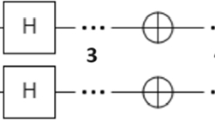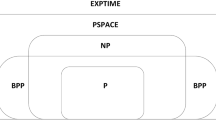Abstract
Carrying out the classification of patterns in a two-qubit system by separately using Grover’s and Ventura’s algorithms on different possible superposition, it has been shown that the exclusion superposition and the phase-invariance superposition are the most suitable search states obtained from two-pattern start-states and one-pattern start-states, respectively, for the simultaneous classifications of patterns. The higher effectiveness of Grover’s algorithm for large search states has been verified but the higher effectiveness of Ventura’s algorithm for smaller data base has been contradicted in two-qubit systems and it has been demonstrated that the unknown patterns (not present in the concerned data-base) are classified more efficiently than the known ones (present in the data-base) in both the algorithms. It has also been demonstrated that different states of Singh-Rajput MES obtained from the corresponding self-single- pattern start states are the most suitable search states for the classification of patterns |00>,|01 >, |10> and |11> respectively on the second iteration of Grover’s method or the first operation of Ventura’s algorithm.




Similar content being viewed by others
References
Singh, M.P., Rajput, B.S.: Role of entanglement in quantum neural networks (QNN). J Mod. Phys. 6, 1908–1920 (2015)
Wootters, W.K.: Entanglement of Formation and Concurrence. Q. Inf. Comput. 1(1), 27–44 (2001)
Wang, Z.S.: Geometric quantum computation and dynamical variable operators. Phys. Rev. A79, 024304–308 (2009)
Cuffing, D.: Would QNN be subject to decidability constraints of church-turing thesis. Neural Netw. World. 1, 163–168 (1999)
Hoggs, T., Portnov, D.: Quantum optimization. Inf. Sci. 128, 181–197 (2000)
Zak, M.: Quantum decision making. Inf. Sci. 128, 199–215 (2000)
Singh, M.P., Rajput, B.S.: Maximally entangled states of two-qubit systems. Int. J. Theor. Phys. 52, 4237–4255 (2013)
Singh, M.P., Rajput, B.S.: Applications of Singh-Rajput MES in recall operations of quantum associative memory for a two-qubit system. Int. J. Theor. Phys. 54(10), 3443–34460 (2015)
Singh, M.P., Rajput, B.S.: Processes of quantum associative memory (QuAM) through new maximally entangled states (Singh-Rajput MES). Int. J. Theor. Phys. 55 (2), 124–140 (2016)
Singh, M.P., Rajput, B.S.: New maximally entangled states for pattern association through evolutionary process in a two-qubit system. Int. Journ. Theor. Phys. 56, 1274–1285 (2017)
Singh, M.P., Rajput, B.S.: New maximally entangled states and Pattern classification. Int. Journ. Theor. Phys. 53(9), 3226–3238 (2014)
Grover, L.K.: A fast quantum mechanical algorithm for data base search. In: Proceedings of 28th Annals ACM. Symposium On Theory of Computing, pp 212–221. ACM Press, Philadelphia (1996)
Grover, L.K.: Quantum mechanics helps in searching for a needle in haystack. Phys. Rev. Lett. 79, 325–328 (1997)
Tittel, W., Bendel, J., Zbinden, H., Gisin, N.: Quantum cryptography using entangled photons in energy-time bell states. Phys. Rev. Lett. 84, 4737–4740 (2000)
Singh, M.P., Rajput, B.S.: Pattern Classification in two-qubit and three-qubit systems. Euro. Phys. J. Plus 129(57), 1–13 (2014)
Grover, L.K.: Super classical search algorithm to find an element in unsorted array. Phys. Rev. Lett. 78, 325–328 (1997)
Ventura, D.: On the utility of entanglement in quantum neural computing. In: Proceedings of International Joint Conference on Neural Networks, pp 1565–1570 (2001)
Ventura, D., Martinez, T.: Quantum associative memory. Inf. Sci. 124, 273–296 (2000)
Singh, M.P., Radhey, K., Saraswat, V.K., Kumar, S.: Classification of patterns representing apples and oranges in three –qubit system. Quant. Inf. Proc. 16 (1), 1–24 (2017)
Singh, M.P., Radhey, K., Kumar, S.: Simultaneous classification of oranges and apples using grover’s and ventura’ algorithms in a two-qubits system, Int. J. Theor. Phys. 56, 2521–2534 (2017)
Arima, K., Miyajima, H., Shigei, N., Maeda, M.: Some properties of quantum data search algorithms, the 23rd international conference on circuits/systems, Computers and Communications (ITC-CSC)
Acknowledgments
Authors thankfully acknowledge the financial support of University Grants Commission (UGC), New Delhi (India) in the form of a major research project: MRP-Major-Comp-2013-39460.
Author information
Authors and Affiliations
Corresponding author
Rights and permissions
About this article
Cite this article
Singh, M., Radhey, K. & Rajput, B.S. Pattern Classifications Using Grover’s and Ventura’s Algorithms in a Two-qubits System. Int J Theor Phys 57, 692–705 (2018). https://doi.org/10.1007/s10773-017-3601-6
Received:
Accepted:
Published:
Issue Date:
DOI: https://doi.org/10.1007/s10773-017-3601-6




